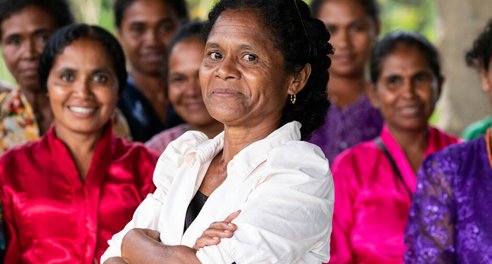CARE International UK has partnered with the UK Government for decades to ensure that its foreign and development policy, including its Official Development Assistance (ODA), delivers for women and girls. FCDO’s latest accounts put this in jeopardy.
Last week, the Foreign, Commonwealth and Development Office (FCDO) released its Annual Report – the clearest indication yet of what this Government is choosing to prioritise as it slashes ODA from 0.5% to 0.3% of Gross National Income over the next three years.
In a world where ODA is shrinking so significantly, we understand that every part of the budget comes under pressure. The Minister for Development has made clear that no department, programme, or priority is exempt. But we know from previous ODA cuts that time and again, the deepest cuts have landed disproportionately on women and girls. Our greatest concern is that once more, women and girls will face the brunt.
Much deeper cuts to the budget are expected this Autumn, but this initial round serves as a crucial test of the Government’s claims that it is still committed to gender equality and advancing the rights of women and girls globally. Here’s our assessment so far...
Some positives
Alongside the Accounts, the Government has published an Equality Impact Assessment (EIA) – a positive step towards transparency. The EIA claims that the 2025/26 aid reductions will not have a disproportionate impact on “equalities” and insists that the proportion of equalities-focused programming for 2025/26 has been maintained. The EIA states this includes funding for gender-based violence (GBV), women’s rights organisations (WROs), women’s economic empowerment, and LGBTQ+ rights. It is encouraging that flagship programme What Works to Prevent Violence: Impact at Scale also seems to have retained funding, at least for the next year. Furthermore, the FCDO’s Research and Evidence Directorate continues to target 80% of its investment towards gender equality outcomes.
At first glance, this sounds like a win for organisations like CAREthat have campaigned to protect standalone funding for gender equality. But dig deeper, and a different picture emerges.
Smoke and mirrors?
The Government says the proportion of bilateral ODA dedicated to equalities is preserved – yet provides no clear breakdown between gender-targeted programmes and those where gender is only mainstreamed. Even more concerning, the EIA groups gender and disability programming under the same umbrella, without disaggregating the data. This makes it impossible to determine the real impact on gender equality or people with disabilities.
The numbers also speak volumes: 11 of the 13 deprioritised programmes – a staggering 85% – are gender equalities-focused, and there will be a 25% reduction in the Government’s Women, Peace and Security work, as well as huge cuts to girls’ education. This sits uneasily alongside the Government’s claim that equalities programming has been preserved. Despite the EIA’s claim that ongoing support for women’s rights organisations has been protected, the report also confirms that funding has been cut to 50 women’s peacebuilding groups in fragile states – a glaring contradiction and a worrying indication of the Government’s commitment to locally-led.
Accountability, accountability, accountability
The Accounts make clear that Government plans to shift more funding into multilateral channels, preserving headline contributions to Gavi and the World Bank whilst reducing support for bilateral programmes that the UK designs and manages directly. Multilateral organisations play a vital role in global development, but this decision is not without trade-offs.
Bilateral programmes often offer greater transparency, targeted focus, and clearer accountability. With multilateral funding, results are typically reported in aggregate, making it harder to track how UK ODA specifically contributes to gender equality. The EIA does not address how this change in delivery model affects outcomes for women and girls, and without strong systems to track gender spending and results across all channels, the UK’s impact becomes harder to measure – and harder to defend.
Finally, the methodology used to assess impact appears fundamentally flawed, as the conflation of data sets make it impossible to truly diagnose impact. Comparing cuts across low-income countries, social determinants, and equalities programming sets an artificially low bar. It conceals the real consequences of deep cuts to women’s health, girls’ education, and rights-based initiatives. In the absence of a clear, disaggregated breakdown of what has been cut – and what has been preserved – the Government’s claims of “protection” for gender equality ring hollow.
Where we need to go from here
We’re calling on the Government to publish the full dataset behind the EIA and clearly distinguish between equalities, and gender-targeted and gender-mainstreamed programmes. Without this, the true impact of these cuts remains hidden – and decision-makers cannot be held accountable.
While the most damaging effects may have been delayed, the threat to standalone gender programming is real and urgent. Decades of evidence – including from the Government’s own analysis – shows that relying solely on gender mainstreaming is not enough to tackle structural inequality. Without targeted funding, gender-based violence cannot be prevented. Girls don’t have safe spaces to learn. Women are locked out of decision-making.
The bottom line is, gender equality and women’s rights are under attack around the world and at the same time, governments are pulling funding from the very programmes and organisations working to defend them. A credible, modern approach to development cannot involve the UK standing by – or worse, complicit – as this rollback continues. The UK’s commitment to gender equality must be boldly championed, clearly prioritised, and transparently delivered.



